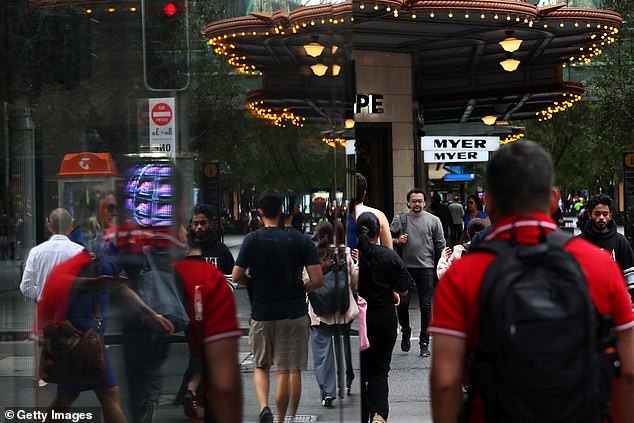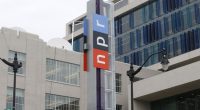Australia’s unemployment rate has shot up to the highest level since late 2021, when Sydney and Melbourne were emerging from Covid lockdowns.
The jobless rate of 4.3 per cent in June was the highest since November 2021, with 33,600 people losing their jobs and boosting the prospect of an August rate cut.
This occurred as the number of full-time jobs fell by 38,000 while 40,000 part-time jobs were created, signalling a sharp drop in working hours.
Canberra, the home of federal public servants, had Australia’s lowest jobless rate of 3.6 per cent. This was a result of federal government spending hitting the highest level since 1986 outside of the pandemic.
Australian Industry Group chief executive Innes Willox said public sector job growth was holding up as private sector demand for labour weakened.
‘For over a year, there has been negligible job growth in the private market sector, with government-supported employment in the public and non-market sectors doing the heavy lifting,’ he said.
‘A rise in unemployment to its highest level since the pandemic points to the impact that our weak private sector is having on the labour market.
‘With the private market sector accounting for two-thirds of employment in Australia, it was inevitable that its sustained weakness would eventually spill over to the broader labour market. It appears this problem is now coming home to roost.’

Australia’s unemployment rate has shot up to the highest level since late 2021 when Sydney and Melbourne were emerging from Covid lockdowns (pictured is Sydney’s Pitt Street Mall)
Unemployment was higher than average in New South Wales and Victoria where migrant numbers are highest.
‘Excessive migration has played a significant role in pummelling Australia’s economic productivity,’ Institute of Public Affairs deputy executive director Daniel Wild said.
‘It has created extended periods of negative per capita economic growth, and exacerbated the housing and rental crises.
Australia’s unemployment rate also rose for the first time since December even though the Reserve Bank had cut interest rates in February and May.
The latest jobless data from the Australian Bureau of Statistics is also worse than the RBA was forecasting in its May statement on monetary policy, with the 4.3 per cent figure slightly higher than the 4.2 per cent level it had predicted.
The bad news on the labour market could make the Reserve Bank more inclined to cut rates on August 12 should upcoming June quarter inflation data show a moderation in underlying price pressures.
KPMG chief economist Brendan Rynne said the fact that 34,000 more people are looking for work would make a rate cut next month more likely.
‘While quarterly inflation data is still a week or so away, today’s data will reinforce the weakness that is continuing within the private side of the Australian economy, and even by itself should be enough for the RBA to drop the cash rate at its next meeting,’ he said.

The jobless rate of 4.3 per cent in June was the highest since November 2021, with 33,600 people losing their job last month
The RBA surprised financial markets earlier this month when it kept the cash rate on hold at 3.85 per cent.
Governor Michele Bullock argued the underlying inflation rate of 2.9 per cent was still too high in the March quarter, even though it is within the RBA’s two to three per cent target.
AMP economist My Bui said just 2,000 new jobs were created in June, compared with market expectations of 20,000, which suggested the labour market was softening, with employers mainly hiring new part-time staff.
‘Today’s jobs data suggests a potentially broad weakening in the labour market,’ she said. ‘The composition of jobs gains was also weak.’
This also suggested unemployment was now at a level less likely to fuel inflationary wage increases.
‘We believe that the state of the Australian labour market is more balanced than tight and is not a source of inflationary pressures, warranting a rate cut in the August meeting,’ Ms Bui said.
AMP is expecting the RBA to cut rates in August, November, February and May, which would take the cash rate down to 2.85 per cent for the first time since December 2022.
That is slightly more optimistic than the futures market pricing for a 3.1 per cent cash rate by early next year.
Victoria was by far Australia’s worst performing labour market with the highest jobless rate of 4.6 per cent, even though Melbourne receives a large share of overseas migration.
New South Wales and South Australia had higher-than-average jobless rates of 4.4 per cent.
Queensland and Western Australia had below-average rates of 4.1 per cent.
The Australian Capital Territory, the home of federal public servants in Canberra, had the lowest jobless rate of 3.6 per cent, which was better than Tasmania’s 3.8 per cent level and the Northern Territory’s 3.9 per cent.
National unemployment has risen despite rapid population growth, with 447,620 migrants moving to Australia on a permanent and long-term basis in the year to May.
This was 33.6 per cent higher than the 335,000 level Treasury forecast for the 2024-25 financial year that ended in June.







